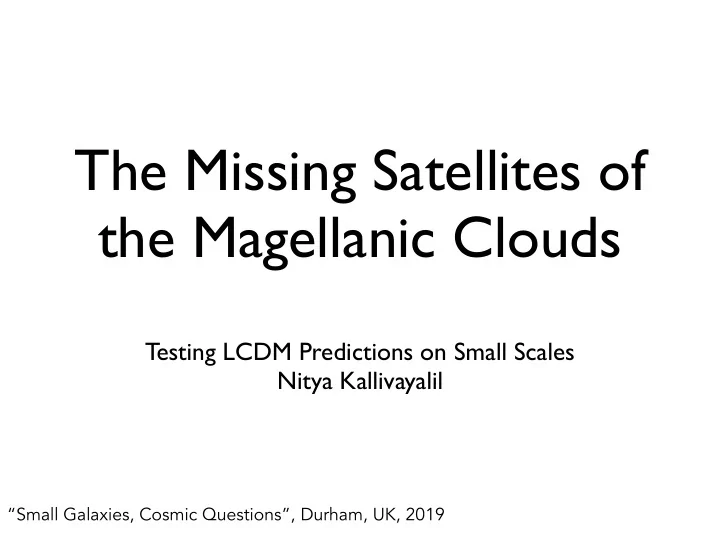

The Missing Satellites of the Magellanic Clouds Testing LCDM Predictions on Small Scales Nitya Kallivayalil “Small Galaxies, Cosmic Questions”, Durham, UK, 2019
Ultra-Faint Intrigue [M * ∼ (0.1–1) × 10 4 M ⦿ ; M halo ~ 10 8 M ⦿ ] • How do galaxies populate the lowest mass halos? • Missing Satellites Problem (e.g., Klypin et al. 1999; Moore et al. 1999; see Nierenberg+ 2016 at higher z) • Low densities of dwarf galaxies: core vs. cusp, and Too Big to Fail (e.g. Boylan-Kolchin et al. 2011; Garisson-Kimmel et al. 2014; Ostriker et al. 2019) Diemand et al.
How many Magellanic satellites does LCDM predict? Dooley+17: 2-12 UFDs with M * > 10 4 M ⦿ Group infall: Wetzel et al. 2015; Deason et al. 2015: ∼ 30% of M ∗ ︎ ~ 10 5 M ⊙ satellites of Milky Way hosts fell in as a group Sales et al. 2013 (see also Guo et al. 2011, D’Onghia & Lake 08, Li & Helmi 2008)
The Infalling LMC system NK et al. 2018; Sales et al. 2017 See also: Jethwa et al. 2016; Yozin and Bekki 2015; Deason et al. 2015
Gaia DR2 PMs of Ultra-faints: Hydrus 1 NK et al. 2018 DR2 UFD PMs from spectroscopic samples: Simon 2018; Fritz et al. 2018 Adding photometric information: NK et al. 2018; Pace & Li 2018; Massari & Helmi 2018
+ + + - - - + + + - - - - + + + - - - - - + + + - - - - + + + - - - - - - + + + - - - - - + + + - - - - + + + - - - - - + + + - - - - + + + - - - - + + + - - - - - + + + - - - - + + + - - - - + + + - - - - - Orbital Poles of successfully measured systems NK et al. 2018
Velocities and Distances NK et al. 2018
Predictions for galaxies without PMs: Phx2 NK et al. 2018; see also Pace & Li 2018 - Newly measured RV from Fritz et al. 2018
Orbital modeling of satellites associated with the MCs 500 150 LMC ∆ T = 3 Gyr SMC M vir , MW = 10 12 M � Hor1 100 Car2 M vir , LMC = 1 × 10 11 M � 400 Car3 M vir , SMC = 3 × 10 9 M � Hyd1 50 Phx2 300 0 R vir, MW Y [kpc] Z [kpc] − 50 200 − 100 R vir, LMC 100 − 150 0 − 200 − 250 − 150 − 100 − 50 0 50 100 150 200 0 100 200 300 400 500 X [kpc] Y [kpc] Erkal & Belokurov 2019 Patel+19, in prep.
Consistent with LCDM? Jahn et al. 2019 - See also Munshi et al. 2019 dSphs: new Gaia DR2 PMs; Helmi et al. 2018 Pardy et al 2019: case for Carina and Fornax But see Erkal & Belokurov 2019
Conclusions • Proper motions are key in enabling near-field cosmology: mass and origin. • We conclude that four ultra-faint systems Hor1, Car2, Car3, and Hyi1) are members of the Magellanic Cloud system. • Another 4 galaxies (Phx2, Dra2, Hya2 and Ret 2) are highly likely members. • Carina and Fornax are two dSphs that may be associated with the LMC system. • Consistent with LCDM LMC mass systems?
Recommend
More recommend